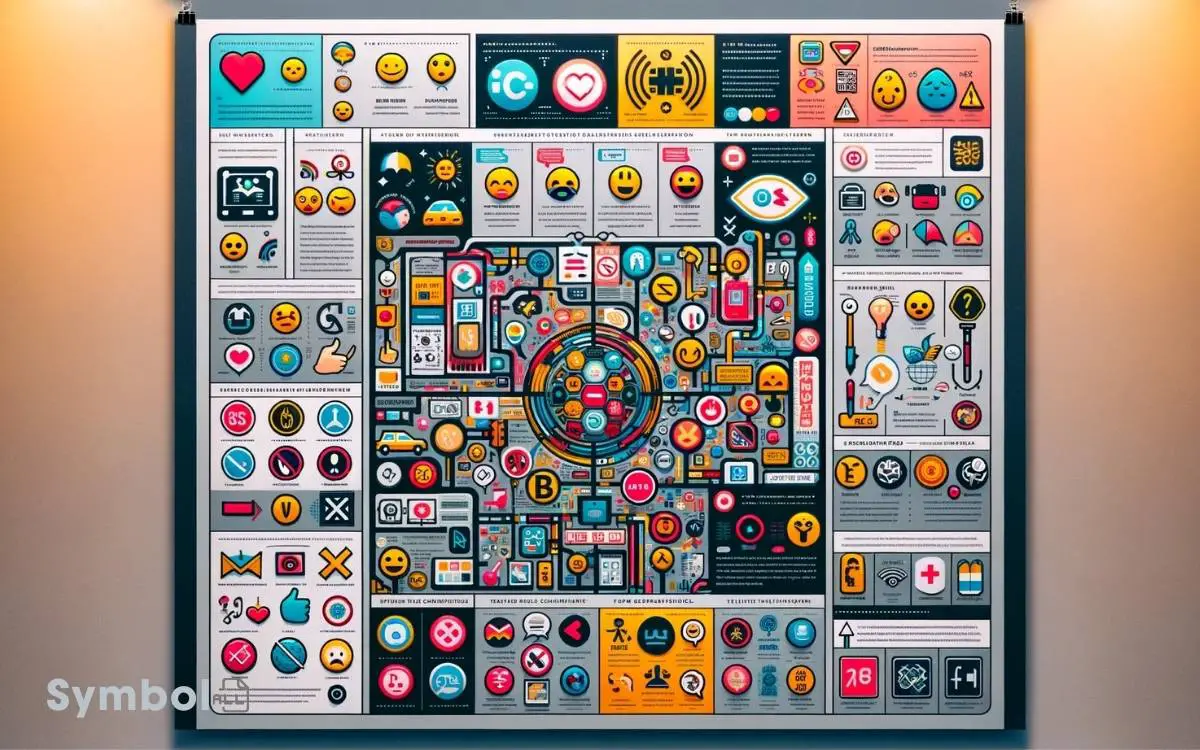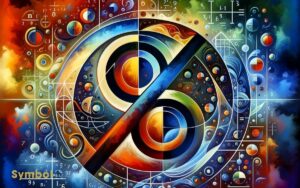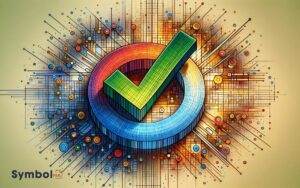Use of Symbols in Communication: Enhancing Understanding!
Symbols in communication let you convey complex concepts and emotions quickly. From ancient cave paintings to modern emojis, they’ve mirrored cultural shifts and technological progress.
They encapsulate stories, beliefs, and values, acting as a bridge between diverse cultures. Symbols vary dramatically across cultures, stressing the importance of context for accurate interpretation.
In the digital realm, emojis add depth to conversations, making interactions more expressive. In branding, symbols forge emotional connections, building lasting consumer relationships.
Exploring these symbols offers a deeper understanding of human connections and cultural narratives, inviting you on a journey to unlock their layered meanings.

Key Takeaways
17 Symbols and Their Role in Effective Communication
| Symbol | Name | Common Use Cases in Communication |
|---|---|---|
| @ | At sign | Email addresses, social media mentions, tagging users |
| # | Hashtag | Tagging topics in social media, categorizing posts |
| & | Ampersand | Connecting items, especially in business names and writing |
| * | Asterisk | Indicating footnotes, corrections, multiplication in text |
| % | Percent sign | Representing percentages, sales discounts, data analysis |
| $ | Dollar sign | Indicating currency, pricing information, financial transactions |
| ~ | Tilde | Approximation, negation in logic, home directory in Unix systems |
| -> | Arrow | Showing direction or progress, pointers in programming |
| 🙂 | Smiley Face | Conveying happiness or satisfaction in informal communication |
| 🙁 | Sad Face | Conveying sadness or disappointment in informal communication |
| 😉 | Wink | Hinting at a joke or inside knowledge in informal communication |
| ” “ | Quotation marks | Denoting speech, quoting sources, highlighting phrases |
| : | Colon | Time notation, separating titles from subtitles, in lists |
| ; | Semicolon | Connecting related independent clauses, in lists with descriptions |
| … | Ellipsis | Indicating omissions, pauses in conversation, unfinished thoughts |
| ! | Exclamation mark | Showing strong emotion, commands, high volume in speech |
| ? | Question mark | Denoting questions, requesting information, expressing doubt |
The Evolution of Symbolism
The evolution of symbolism, a cornerstone in human communication, has transformed significantly from ancient cave paintings to today’s digital emojis, reflecting cultural shifts and technological advancements.
Initially, symbols served as primitive forms of storytelling and record-keeping, encapsulating complex narratives within simple visual forms.
As civilizations advanced, so did their symbols, evolving into intricate scripts and heraldic emblems that denoted status, identity, and allegiance.
In the modern era, the digital age has ushered in an era of emojis and icons, compressing emotions and ideas into universally recognizable graphics.
This shift not only highlights humanity’s relentless pursuit of efficiency in communication but also underscores the dynamic nature of symbolism, adapting to the changing landscapes of society and technology while retaining its fundamental role in human expression.
Understanding Iconography
Delving into iconography, you’ll uncover the layered meanings behind symbols used in various cultures, revealing how they communicate complex ideas, emotions, and identities with remarkable precision.
Through iconography, you’re not just seeing an image but engaging with a rich tapestry of cultural narratives and historical contexts.
Each symbol, whether it’s a religious icon, a national emblem, or a brand logo, serves as a concise capsule of information, designed to evoke specific responses and convey particular values or beliefs.
Symbols Across Cultures
Building on your understanding of iconography, let’s explore how symbols function differently across various cultures, highlighting their unique roles in communication and identity construction.
You’ve seen how symbols can represent complex ideas, beliefs, and values. Now, consider that these symbols aren’t universal; their meanings can shift dramatically from one culture to another.
For example, the color white symbolizes purity and peace in many Western cultures, yet it represents mourning and death in some Eastern societies. Similarly, an animal considered sacred in one culture mightn’t hold the same reverence elsewhere.
This variability underscores the importance of cultural context in interpreting symbols. Understanding these differences is crucial, as it fosters respect and enhances cross-cultural communication, enabling you to navigate the global landscape more effectively.
The Impact of Emojis
In our digital age, emojis have transformed the way we communicate, adding a layer of emotional nuance and expression to text-based conversations.
You’ve likely noticed how a smiley face can soften a message or how a heart can express more than words alone. Emojis serve as a bridge, conveying feelings and intentions that words might fail to capture.
| Emojis | Impact |
|---|---|
| 😂 | Transforms plain text into playful, relatable communication. |
| 😔 | Allows for the expression of empathy and understanding without lengthy explanations. |
| ❤️ | Conveys affection and support, strengthening bonds in digital interactions. |
This concise language of symbols enables you to communicate complex emotions and reactions swiftly, enriching digital dialogue in a way traditional text cannot. Emojis don’t just supplement our messages; they often carry the conversation, showcasing the power of visual language.
Symbolism in Branding
You’ve seen how symbols forge connections in personal communication; now consider their power in branding. Symbols have the power to evoke emotion, tell stories, and create deep-rooted associations in the minds of consumers. In fact, many brands carefully leverage their use to convey identity and values, offering something that feels universally understood. For instance, the use of religious symbols in advertising can tap into cultural significance and shared meanings, but it also risks misinterpretation or alienating certain audiences if not handled with sensitivity.
Symbols meticulously crafted for brands can encapsulate identity and foster deep emotional ties with consumers.
They’re not just logos; they’re the essence of a brand’s narrative and values, engaging audiences on a profound level.
Brand Identity Creation
Crafting a brand’s identity often hinges on the strategic use of symbols to communicate core values and connect emotionally with consumers.
This symbolic representation isn’t just about logos or taglines; it’s a comprehensive strategy that involves:
- Color schemes that evoke specific emotions or associations.
- Typography that reflects the brand’s personality, be it traditional or modern.
- Icons and motifs that are easily recognizable and tie back to the brand’s narrative.
- Packaging design that reinforces brand values and stands out on the shelf.
Emotional Connection Building
Symbols play a vital role in forging an emotional connection between a brand and its audience, acting as the bridge that conveys deeper meanings and values.
By carefully selecting symbols that resonate with their target demographic, brands can evoke specific emotions and feelings, laying the foundation for a strong emotional bond.
You’ll notice how iconic brands utilize symbols that embody their core values, such as freedom, innovation, or reliability, making these concepts tangible for you. This strategy transforms passive consumers into loyal advocates, deeply attached to what the brand stands for.
It’s not just about the visual aesthetic; it’s about embedding these symbols into the brand’s narrative, ensuring they’re consistently presented across all platforms, solidifying that emotional connection.
Through this meticulous process, symbols become powerful tools in building lasting relationships with you.
Digital Symbols in Social Media
Navigating the landscape of social media, you’ll encounter a myriad of digital symbols that serve as a complex language of expression and interaction.
These symbols, while seemingly simple, carry profound implications for how we communicate and understand one another in the digital realm.
- Emojis: Convey emotions and nuances that words alone might miss.
- Hashtags: Connect conversations and topics, creating communities around shared interests.
- Memes: Blend humor and commentary, reflecting societal trends and individual sentiments.
- Reactions: Offer immediate feedback, allowing for a nuanced range of responses beyond mere text.
Analyzing these symbols, you’ll find they’re not just digital shorthand but pivotal tools that shape the way we engage, empathize, and connect with each other online. They stand as both markers of cultural zeitgeist and personal identifiers in the sprawling, interconnected web of social media.
The Role of Symbols in Art
Just as digital symbols transform communication in social media, symbols in art embody deep meanings and connect viewers to broader themes and emotions.
Artists leverage symbols as a visual shorthand, conveying complex narratives and evoking strong emotional responses without the need for words.
These symbols can range from universally recognized motifs to deeply personal icons, each chosen for its ability to communicate layers of meaning.
In your journey through art, you’ll find that symbols serve not only as anchors for interpretation but also as bridges between the artist’s intent and your personal experience.
By integrating symbols, artists craft a dialogue that invites you to explore beyond the surface, encouraging a deeper engagement with the work.
Understanding this role enhances your appreciation of art’s power to communicate profound human truths.
Interpreting Common Symbols
While exploring the realm of art, you’ll often encounter common symbols whose meanings transcend time and culture, offering a window into the universal human experience.
These symbols, when interpreted accurately, illuminate the depths of human emotions, beliefs, and values.
To guide your understanding:
- The Heart: Symbolizes love, passion, and deep emotional connections.
- The Dove: Represents peace, purity, and innocence.
- The Skull: Denotes mortality, the transient nature of life, and the human fascination with the afterlife.
- The Tree: Embodies growth, strength, and a connection to the natural world.
Each symbol, rich in historical and cultural significance, invites you to delve deeper into the narrative being conveyed, enhancing your appreciation and comprehension of the art before you.
Future Trends in Symbolic Communication
As you explore the future trends in symbolic communication, you’ll observe the rapid evolution of emoji language, becoming more nuanced and expressive.
Simultaneously, virtual reality introduces a complex lexicon of gesture codes, requiring users to learn a new, immersive form of interaction.
Augmented reality, meanwhile, seamlessly integrates icons into our physical world, enhancing daily communication with a layer of digital information.
Evolving Emoji Language
In the realm of digital communication, the emoji language is rapidly evolving, mirroring societal changes and technological advancements. You’re witnessing a dynamic shift in how emotions, ideas, and messages are conveyed through these colorful, symbolic images.
- Diverse skin tones and hairstyles reflect a growing emphasis on inclusivity and representation.
- New emojis illustrating everyday objects and actions enhance the precision of digital conversations.
- Animated emojis add depth to messages by conveying emotions more vividly.
- Custom emoji creation tools empower users to personalize communication further.
This evolution signifies not just technological progress but a deeper cultural shift towards more nuanced and inclusive digital expression.
As you adapt to these changes, your ability to communicate effectively and empathetically in the digital space grows, showcasing the emoji language’s role as a living, breathing form of modern communication.
Virtual Reality Gesture Codes
Diving into the realm of virtual reality, gesture codes emerge as a groundbreaking trend in symbolic communication, offering a nuanced and immersive way to convey messages and emotions.
You’ll find that these codes transform interactions, making them more intuitive and engaging. Imagine, with a simple hand movement, you’re able to express a complex sentiment or command within a virtual environment.
This evolution reflects a shift towards non-verbal, yet profoundly expressive forms of communication, harnessing the full potential of human gestures.
As you navigate this digital landscape, you’ll notice how gesture codes are meticulously designed to be universally understood, bridging language barriers and enhancing connectivity.
They’re not just commands; they’re an innovative way to foster deeper connections and understanding in the virtual realm.
Augmented Reality Icon Integration
Building on the innovative use of gestures in virtual reality, augmented reality (AR) icon integration represents the next frontier in symbolic communication, offering a more nuanced interaction with our digital surroundings.
This evolution in symbolic communication harnesses the power of AR to blend icons seamlessly into our physical environment, enhancing the way we interact with technology on a daily basis.
Consider the following imagery:
- A digital arrow displayed on your car’s windshield, guiding your way through unfamiliar streets.
- Icons floating beside museum exhibits, offering in-depth historical insights with a simple gaze.
- Virtual tools appearing on a mechanic’s workbench, providing immediate, interactive guidance.
- Social media notifications popping up around friends in a crowd, highlighting shared interests and connections.
This leap towards augmented reality icon integration is reshaping our communication landscape, making interactions more immersive, intuitive, and meaningful.
Conclusion
In the tapestry of human connection, symbols serve as the vibrant threads weaving our thoughts and emotions into a shared understanding.
From the ancient etchings in caves to the digital emojis punctuating our messages, symbols transcend language barriers, embodying a universal language.
As you navigate the ever-evolving landscape of symbolic communication, remember, each icon, emoji, and logo carries a weight beyond its simple design, painting the canvas of our collective consciousness with rich, nuanced meanings.
Embrace this evolving lexicon, for it shapes our world in profound ways.





